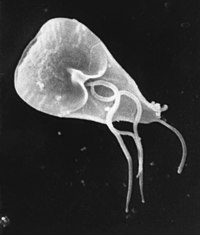
Photo from wikipedia
Avian species have long struggled with the problem of coccidiosis, a disease that affects various parts of the intestine, including the anterior gut, midgut, and hindgut. Among different types of… Click to show full abstract
Avian species have long struggled with the problem of coccidiosis, a disease that affects various parts of the intestine, including the anterior gut, midgut, and hindgut. Among different types of coccidiosis, cecal coccidiosis is particularly dangerous to avian species. Chickens and turkeys are commercial flocks; thus, their parasites have remained critical due to their economic importance. High rates of mortality and morbidity are observed in both chickens and turkeys due to cecal coccidiosis. Coccidiostats and coccidiocidal chemicals have traditionally been added to feed and water to control coccidiosis. However, after the EU banned their use because of issues of resistance and public health, alternative methods are being explored. Vaccines are also being used, but their efficacy and cost-effectiveness remain as challenges. Researchers are attempting to find alternatives, and among the alternatives, botanicals are a promising choice. Botanicals contain multiple active compounds such as phenolics, saponins, terpenes, sulfur compounds, etc., which can kill sporozoites and oocysts and stop the replication of Eimeria. These botanicals are primarily used as anticoccidials due to their antioxidant and immunomodulatory activities. Because of the medicinal properties of botanicals, some commercial products have also been developed. However, further research is needed to confirm their pharmacological effects, mechanisms of action, and methods of concentrated preparation. In this review, an attempt has been made to summarize the plants that have the potential to act as anticoccidials and to explain the mode of action of different compounds found within them.
Journal Title: Frontiers in Veterinary Science
Year Published: 2023
Link to full text (if available)
Share on Social Media: Sign Up to like & get
recommendations!